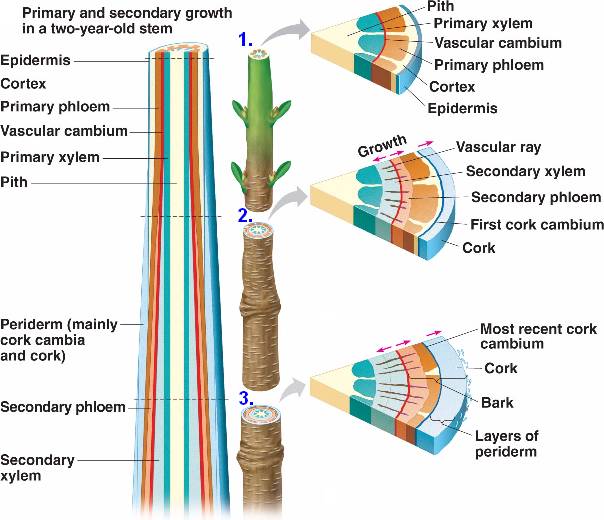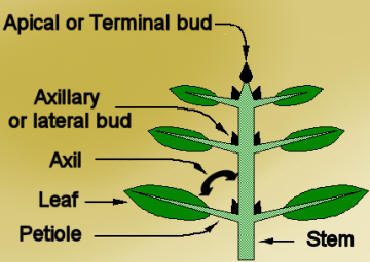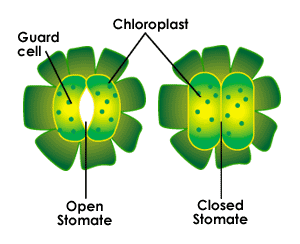My babies have gotten so big it makes me so happy :) But this is not as big as they will get! Eventually my babies will undergo reproduction. They will produce flowers which have petals, sepals, stamens, carpels, and pollen. The sepals protect the floral bud before it opens and the petals attract insects and other pollinators to the plant with their color and fragrance. The stamen is the male reproductive organ of a flower. Each stamen generally has a stalk called the filament. At the top of the filament is the anther and pollen sacs.The center of this organism is where the reproductive process of pollination takes place. The carpel is the female reproductive organ of a flower. Each carpel has a stigma which is where pollen is deposited, the style which is the stalk between the stigma and ovary, and the ovary which holds the ovules for fertilization. The pollen fertilizes the ovule in the ovary and eventually develops into a seed. Then the seed will eventually fall to the ground and being the growth of another baby plant! Double fertilization is when two sperm fertilize one egg! One sperm will actually fertilize the egg that will develop into an embryo. The other sperm combines with the two polar nuclei located in the center and forms a triploid endosperm nucleus. The endosperm basically provides extra nutrient for the seed!
Sunday, April 21, 2013
Monday, April 15, 2013
First corn internode!
Baby corn experienced her first internode today! It's small, but still there. Remember, this is the area between the nodes. Baby tomato is a beaut. You may also see how baby tomato is growing towards the window, or actually the light coming in the window! This is because of phototropism which is a plants growth in response to light. Tomato is growing towards the light because the cells on tomato that are farthest from the light have a chemical hormone called auxin which causes the plant to have elongated cells on the farthest side from the light, bending the plant towards the stimuli. Another hormone that plants have is cytokinins which promotes cell division (cytokinesis) in plant roots and shoots. When baby tomato and corn first started sprouting it was because of cytokinins promoting cell growth! This growth takes place in the meristem, which is the site of repeated cell division. Primary growth occurs at the apical meristems where the structure is elongated and secondary growth occurs at the vascular cambium and cortex cambium, where the structure is increased in width.


Sunday, April 14, 2013
First corn leaf!
Baby corn produced her first leaf. I am so proud! Baby tomato is still growing strong with many internodes and leaves!
Thursday, April 11, 2013
Mmmm food...
I was feeling a little hungry earlier and it made me think, how are my babies eating? They don't have mouths! And what do they like? Pizza? Cheeseburgers? Then it occurred to me, plants get food through translocation! Translocation is the movement of materials from the leaves to other parts of the plant. When photosynthesis occurs, plants produce sugars in their leaves which becomes a source for other parts of the plant such as the roots, flowers, fruits, stems, and other developing leaves. The phloem moves nutrients throughout the plant. It is made of long, continuous strands called vascular bundles which extend through the roots and stem and reach into the leaves as veins.
Wednesday, April 10, 2013
GROWTH!!!
BABY CORN HAD HER FIRST COTYLEDON!!!! Finally! Only one so far but hopefully more will come! And baby tomato is doing very well. She is getting so big! At the top of the cotyledon for my baby corn you can see it is sort of pointed. This shows that the cotyledon has a coleoptile on it which is a pointed protective sheath covering the cotyledon while it emerges from the root and ground. It is quite pale and now that its above the ground it'll stop growing and my baby corn will continue to grow out of it.
Tuesday, April 9, 2013
ROOOOOOOTS!
It's such an exciting day when you come home to see root growth from your baby corn! Finally some growth from the new monocots, only one though!
Monday, April 8, 2013
Friday, April 5, 2013
New plants!
The plastic bag did nothing in helping my poor baby corn grow, I guess they died. So I replanted new ones (middle)! Hopefully they'll grow this time! Also, baby tomato grew her first internodes! Internodes distance one node from another, and a node is what holds buds while they grow into leaves! Buds are undeveloped flowers or shoots in a plant, and the terminal bud is located at the tip of a stem.




Tuesday, April 2, 2013
Plastic Bag?
Today I tried to keep my babies warmer by covering them with a plastic baggy. Hopefully then they'll grow some...
Monday, April 1, 2013
Curiousity killed the... plant?
My dog got a little curious and knocked over my cup for the baby corn... they spilled everywhere and the baby seeds came rolling out. I quickly picked them up and nestled them back into their soil, so I didn't get a picture of the mess. There was not a single indication of growth in any of the seeds... Will they ever grow?
Saturday, March 30, 2013
Twins!
Still no sign of my baby corn. But my baby tomatos surprisingly have 4 sprouts! I guess one seed was twins!
Friday, March 29, 2013
Nutrient and Water Delivery!
 Today when giving my babies a little drink, I began to think about how they got that water from the dirt up to their leaves. They don't have a mouth or anything so how does that happen? Well, plants absorb nutrients and water from the soil through their roots, and their vascular tissues called the xylem transports it up to the leaves. The xylem is able to do this because it is made of long, tracheary elements that specialize in transporting water. It is also composed of parenchyma and fibres. The soil composition is very important to a plant because it provides all necessary nutrients, like nitrogen, a plant needs to grow healthy and without that it could die. A plants phloem, another vascular tissue, transports sugar molecules, amino acids, and hormones both up and down through the plant. Transpiration is leaf evaporation of water through small openings in the plant wall called stomata. Stomata are bordered by guard cells which open and close it to release water evaporation, or keep it in. Turgor pressure is what pushes the plasma membrane against the cell wall of plant cells. Turgidity is caused by the flow of water from an area of low solute concentration outside of the cell into the cell, which has a higher solute concentration. Healthy plant cells are turgid and plants rely on turgidity to maintain structure against the elements. The casparian strip is another important part in water delivery throughout a plant. Casparian strips are waterproof bands which run around the cell wall of endodermal cells in plant roots. Their purpose is to force water which has been following the apoplastic pathway, into the living protoplast of the endodermal cell. Mineral ions in the water are actively transported into the xylem, meaning the xylem now has a lower water potential than the endodermal cell, causing the water to move into the xylem through osmosis.
Today when giving my babies a little drink, I began to think about how they got that water from the dirt up to their leaves. They don't have a mouth or anything so how does that happen? Well, plants absorb nutrients and water from the soil through their roots, and their vascular tissues called the xylem transports it up to the leaves. The xylem is able to do this because it is made of long, tracheary elements that specialize in transporting water. It is also composed of parenchyma and fibres. The soil composition is very important to a plant because it provides all necessary nutrients, like nitrogen, a plant needs to grow healthy and without that it could die. A plants phloem, another vascular tissue, transports sugar molecules, amino acids, and hormones both up and down through the plant. Transpiration is leaf evaporation of water through small openings in the plant wall called stomata. Stomata are bordered by guard cells which open and close it to release water evaporation, or keep it in. Turgor pressure is what pushes the plasma membrane against the cell wall of plant cells. Turgidity is caused by the flow of water from an area of low solute concentration outside of the cell into the cell, which has a higher solute concentration. Healthy plant cells are turgid and plants rely on turgidity to maintain structure against the elements. The casparian strip is another important part in water delivery throughout a plant. Casparian strips are waterproof bands which run around the cell wall of endodermal cells in plant roots. Their purpose is to force water which has been following the apoplastic pathway, into the living protoplast of the endodermal cell. Mineral ions in the water are actively transported into the xylem, meaning the xylem now has a lower water potential than the endodermal cell, causing the water to move into the xylem through osmosis.Tuesday, March 26, 2013
3 Sprouts!
3 baby tomatos have sprouted! All the baby seeds have developed :) Unfortunately, no corn babies have sprouted yet..
Sunday, March 24, 2013
First Leaf!
My baby tomato grew her first leafs today! These leaves will aid in transpiration and photosynthesis to help my little baby grow. Isn't she beautiful? My baby corn hasn't grown at all yet though.. Leaves and basically the whole outside part of any plant is made up of dermal tissue, which protects it from water loss and injury. A thin, waxy layer called the cuticle covers the dermal tissue, protecting the epidermal cells which are the most common cell type in dermal tissue. Gases and water enter and leave the plant through the stomata in the dermal tissues.
Friday, March 22, 2013
First Cotyledon!
Today I spotted the first cotyledon for my tomato baby! Nothing for my baby corn though.. A cotyledon remember is a part of the seed embryo that becomes the first leaf of the plant, aiding in photosynthesis, and dicots have two of them, which is what a tomato plant is.
Tuesday, March 19, 2013
Moving Day!
Today I moved my soon to be babies to a spot where they could get more sunlight and to be safer away from my dog. I haven't seen any root growth or sprouts yet in either plant.
Sunday, March 17, 2013
First Roots!
Baby tomato grew her first roots today. Its kinda hard to see in the picture, but they're there! Baby corn hasn't grown a thing at all... I wonder when it'll start?
Corn has a fibrous root system, or also called an adventitious root system. It is usually formed by thin, moderately branching roots growing from the stem. Tomatos have a tap root system which is an enlarged, somewhat straight to tapering plant root that grows downward and forms a center from which other roots sprout out of it. Primary roots are the first roots of the plant and originate from the embryo. Lateral roots are roots that extend out of the primary roots and aid in anchoring the plant securely in the soil. All roots have root hairs which are small hairs on the epidermis of the roots which collect water and mineral nutrients from the soil for the plant.
Saturday, March 16, 2013
Life Cycle
Before my babies start growing, I better explain their life cycle. The life cycle of a plant involves the alternation of two generations: gametophyte and sporophyte generations. The sporophyte generation is asexual and has diploid cells, meaning during this phase each cell has two sets of chromosomes. A zygote form the sporophyte when it is fertilized. Meiosis is the division stage, cutting the number of chromosomes in each cell in half, which makes the sporophyte produce haploid spores which will form the next gametyophyte generation. During the gametyophyte generation, gametes are formed and have only one set of chromosomes in them. This phase is sexual. Spores are the first cells in this generation and undergo mitosis which creates identical cells with the same number of chromosomes. Male and female gametes with the same number of chromosomes are formed. When they meet, they fuse together and fertilize, forming the zygote which is now a diploid. Then the cycle repeats when this diploid forms the next alternating sporophyte generation.
Friday, March 15, 2013
The Anticipation is Killing Me...
Germination is the process by which plants emerge from seeds and begin their growth, which is what my babies should be going through very soon! There are four main factors that can influence germination: light, temperature, water, and oxygen. Many seeds are unaffected by light (well I mean they are underground.. pretty dark down there...) but some seeds like in a rainforest won't even begin to germinate until light peeks through the canopy. Temperature affects cellular metabolic and growth rates. There is often a prime temperature for a seed to germinate in, and will not germinate if it differs from that range; many seeds germinate at temperatures slightly above 60-75 degrees Fahrenheit. Water is a requirement for germination, but too much water can drown the seeds. Imbibition is the uptake of water by the seed which leads to the swelling and breaking of the seed coat to allow the seedling to emerge and start growing roots and leaves. Also, oxygen is required in germination for metabolism. It is used in aerobic respiration which is the main source of the seedling's energy until it grows leaves.
Thursday, March 14, 2013
Seed Structure and Function
My baby corn are monocot seeds and my baby tomatos are dicot seeds. Here is the differences between monocots and dicots:
Monocots: embryo with single cotyledon, pollen with single furrow or pore, flower parts in multiples of threes, major leaf veins parallel, stem vascular bundles scattered, adventitious roots, and secondary growth absent. Other examples of monocots are rice, wheat, bamboo, banana, ginger, onion, garlic, lilies, daffodils, iris, orchids, bluebells, tulips, and amaryllis.
Dicots: embryo with two cotyledons, pollen with three furrows or pores, flower parts in multiples of fours or fives, major leaf veins reticulated, stem vascular bundles in a ring, roots developed from radicle, and secondary growth is often present. Other examples of dicots are magnolias, nutmeg, cinnamon, avocado, black pepper, water lily, star anise, and hornwort.
Monocot and dicot seeds contain an embryo which has a cotyledon, epicotyl, and hypocotyl. They also have an endosperm and seed coat. The seed coat forms the wall of the embryo sack and protects the seed. The endosperm is a food supply for the baby seed and contains 3 sets of chromosomes. The embryo is the immature plant, the cotyledon is the seed leaf that first emerges, and the radicle is the root.
Wednesday, March 13, 2013
Planting Day!
I planted 3 baby corn seeds 2 inches deep in a cup of dirt and 3 baby tomato seeds 0.25 inches in a separate cup of dirt. Then I gave my soon to be babies a nice drink of water and took them home!
I placed my soon to be babies in the window sill where they would get plenty of sunlight to begin growth and development.
Subscribe to:
Posts (Atom)































